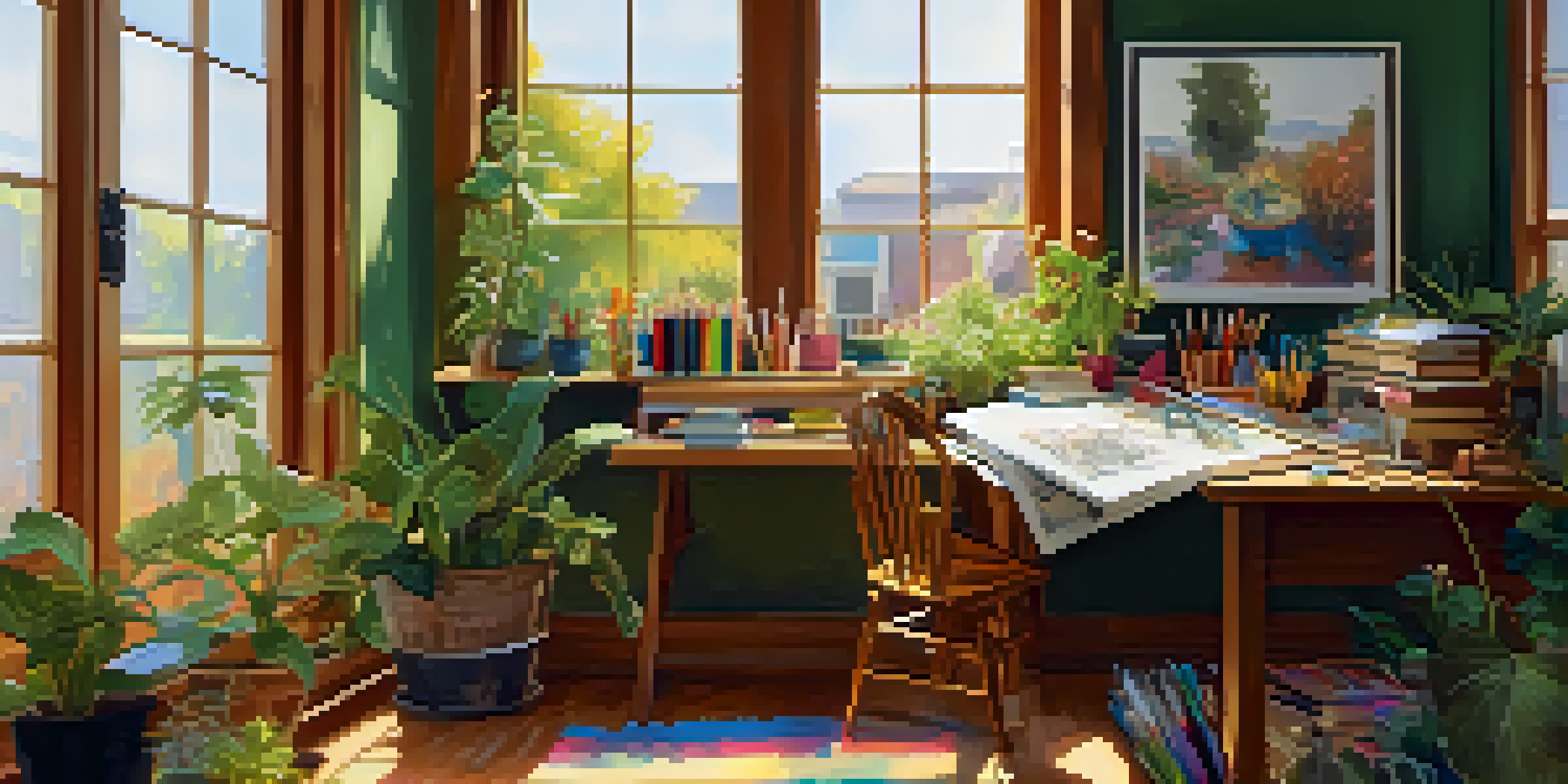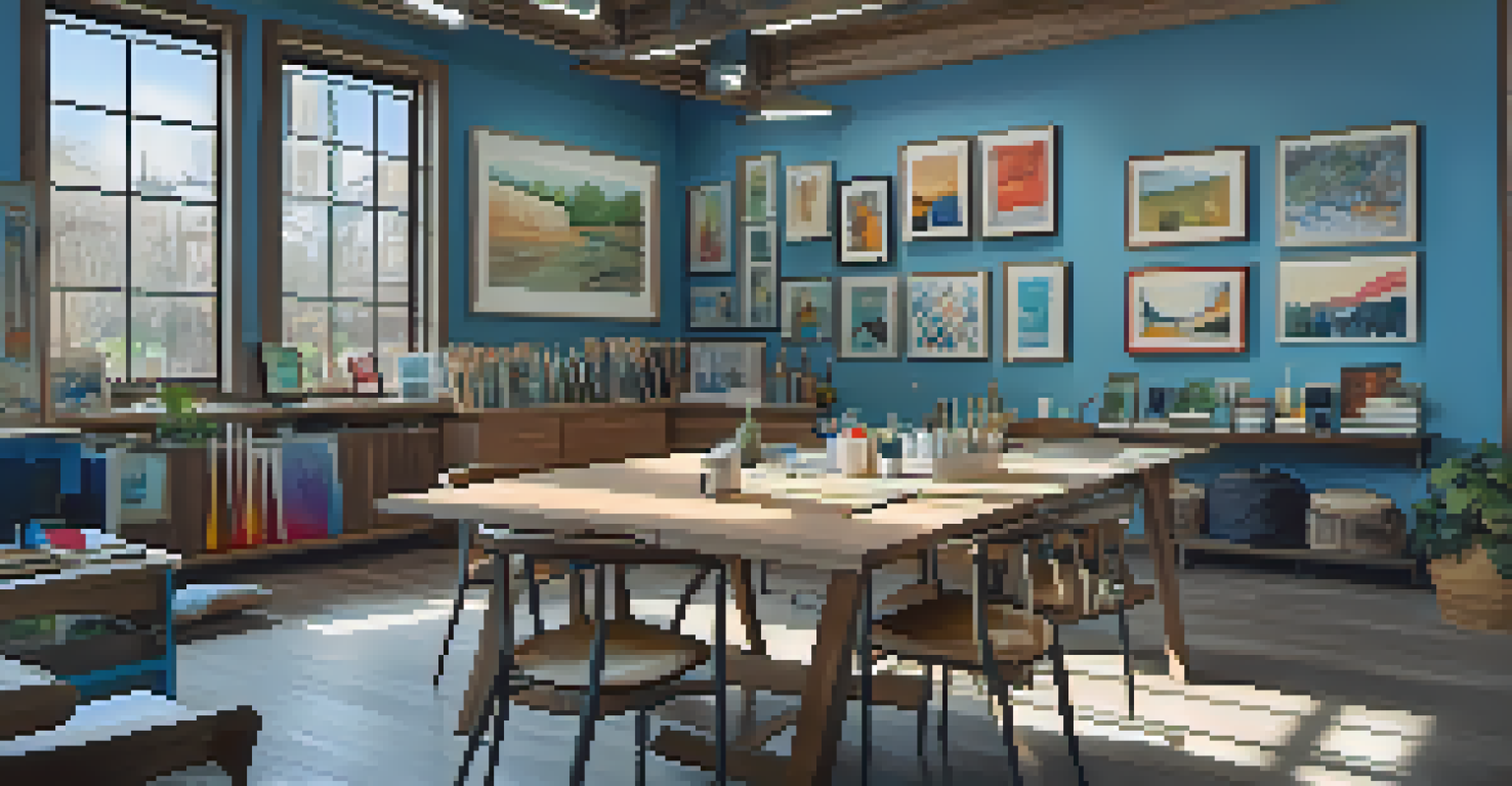Creating a Home Environment That Inspires Artistic Growth

Understanding the Importance of Your Surroundings
Our environment plays a crucial role in shaping our creativity. When you think about it, the spaces we inhabit can either inspire us or stifle our imagination. For artists, a nurturing atmosphere can be the difference between a blank canvas and a flourishing masterpiece.
The environment is not just where we live; it’s a reflection of our creativity and inspiration.
Consider how the colors, textures, and aesthetics around you influence your mood. A well-lit room with vibrant colors can invigorate your spirit and spark new ideas. Conversely, a cluttered or dull space can drain your energy and creativity, making it harder to focus on your art.
By recognizing the impact of your surroundings, you can take intentional steps to create a home that fosters artistic growth. This awareness is the first step toward designing a space that truly inspires you.
Designing a Dedicated Creative Space
Having a dedicated space for your artistic endeavors can significantly enhance your productivity. It doesn’t have to be a large studio; even a small corner can work wonders if it’s tailored to your needs. The key is to have a spot that feels like your own personal sanctuary.

In this creative space, surround yourself with tools and materials that resonate with you. Whether it’s paintbrushes, sketchbooks, or musical instruments, make sure everything is easily accessible. This setup not only streamlines your process but also serves as a constant reminder of your artistic passion.
Your Environment Shapes Creativity
The spaces we inhabit can either inspire our artistic expression or hinder our creative process.
Moreover, consider adding personal touches, like inspiring quotes or artwork from other creators. These elements can stir your imagination and motivate you to dive into your work whenever you step into that space.
Incorporating Nature into Your Artistic Haven
Nature has a unique way of stimulating creativity and inspiring new ideas. Incorporating natural elements into your home can create a calming atmosphere that nurtures your artistic spirit. This can be as simple as adding plants or using natural materials in your decor.
Creativity takes courage.
For instance, studies have shown that having greenery around can reduce stress and enhance focus. Consider placing a few easy-to-care-for plants on your desk or windowsill. They not only purify the air but also bring a sense of tranquility that can help you concentrate on your work.
Additionally, try to incorporate natural light into your creative space. Position your workspace near a window to benefit from sunlight, which can uplift your mood and invigorate your mind. Embracing nature in your home is a surefire way to enhance your artistic growth.
Creating an Inspiring Color Palette
Colors can evoke emotions and set the tone for your creative process. Choosing a color palette for your home that resonates with your artistic style can significantly influence your mood and productivity. Think about what colors inspire you and how they can be incorporated into your space.
For example, warm colors like reds and yellows can energize and stimulate creativity, while cool colors like blues and greens can promote calmness and focus. Experiment with painting walls, using colorful accessories, or even hanging vibrant artwork to create an environment that reflects your artistic sensibilities.
Create a Personalized Creative Space
Designing a dedicated area filled with inspiring tools and personal touches can significantly boost your productivity.
Ultimately, the right color palette can act as a visual muse, sparking inspiration every time you enter your space. By thoughtfully choosing colors, you can create an atmosphere that not only feels good but also boosts your artistic output.
Encouraging Flexibility and Adaptability
Artistic growth thrives in environments that allow for flexibility and change. Your creative space should be adaptable to accommodate different projects and moods. This could mean having movable furniture or a layout that can be easily rearranged.
Think about the different activities you engage in as an artist. Sometimes, you might want to paint, while other times you might prefer to write or sculpt. By creating a space that can morph to suit your needs, you allow your creativity to flow more freely.
Additionally, don’t be afraid to change your space periodically. Rearranging furniture or switching out decor can provide a fresh perspective and reignite your passion for creation. Embracing flexibility in your home can lead to unexpected bursts of inspiration.
Inspiring Connections with Other Creatives
Art is often about connection, both with yourself and with others. Fostering relationships with fellow artists can be incredibly beneficial for your growth. Consider setting up a space in your home that encourages collaboration and social interaction.
This could be a communal workspace where friends can come over to create together or even a cozy corner for hosting creative discussions. Surrounding yourself with like-minded individuals can spark new ideas and encourage you to push your artistic boundaries.
Embrace Flexibility in Your Art Space
A creative environment that allows for adaptability fosters artistic growth and can lead to new bursts of inspiration.
Moreover, sharing your space with other creators can lead to valuable feedback and support. These connections not only enhance your skills but also build a sense of community that can be incredibly motivating.
Establishing a Routine for Creative Flow
Routine can be a double-edged sword in the creative world. While some artists thrive on strict schedules, others find routines stifling. The key is to establish a rhythm that works for you and your artistic process, allowing you to tap into your creativity more consistently.
Start by identifying your most productive times of day and try to align your creative activities accordingly. Whether you’re a morning person or a night owl, leveraging these peak times can enhance your focus and output. Having a clear routine can also help minimize distractions, allowing you to immerse yourself in your work.

Furthermore, consider incorporating rituals into your routine, like a warm-up exercise or a brief meditation. These practices can signal to your brain that it’s time to create, fostering an environment of inspiration and motivation.